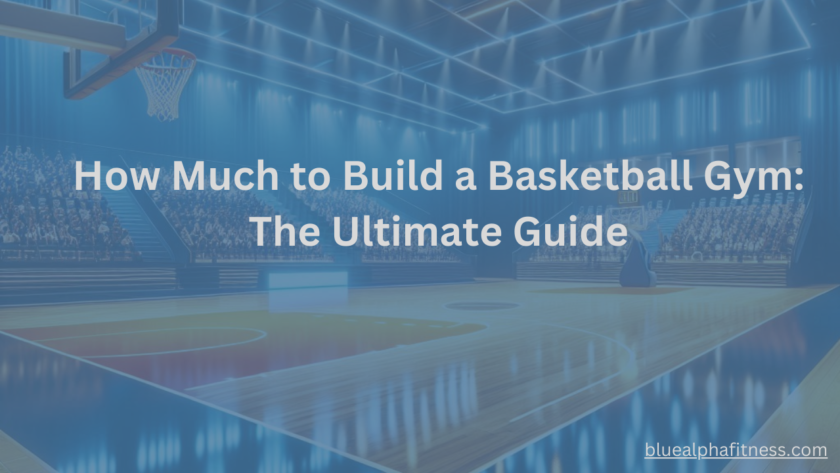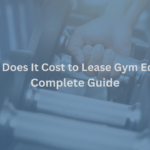Are you wondering how much it would cost to build your own basketball gym but feeling overwhelmed by the potential expenses? You’re not alone
Maybe you’ve been thinking, “Is it even possible without breaking the bank?”
Well, guess what? You’re about to find out, and it might be easier than you think.
Thinking about construction costs can be as nerve-wracking as a last-second free throw. It’s perfectly normal to feel a bit lost or anxious. Who wouldn’t?
With land prices, labor, materials, and all those hidden fees, it’s no wonder you’re feeling overwhelmed.
But here’s the thing: every great project starts with a little bit of uncertainty and a whole lot of questions. And we’re here to tackle them head-on.
So, here’s how much it would cost to build a basketball gym: rough figures range from $350,000 for a basic setup to over $1 million for a full-fledged, top-of-the-line facility.
Yeah, it’s a wide range, but I’ll break it all down for you.
Let’s begin.
How Much Does It Really Cost to Build a Basketball Gym? Complete Cost Analysis
How much it costs to build a basketball gym depends on various factors, from its purpose to location and amenities.
Here’s a detailed breakdown to guide you.
1. Initial Planning and Considerations
Building a basketball gym is a big project.
It’s not just about laying down a court and putting up some hoops. It’s about creating a space that inspires, energizes, and becomes a community hub.
Let’s start with the basics.
· Definine the Purpose
First things first: what’s the gym for? Is it for private use, like in your backyard or a personal property?
Or is it a public facility open to the community, schools, or sports teams?
Maybe it’s for recreational play, or maybe it’s a professional-grade court for serious athletes.
If you’re planning for personal use, you can afford to be a bit more relaxed.
You might not need bleachers or fancy scoreboards.
But if it’s a public or professional space, you’ll need to think about amenities like locker rooms, restrooms, and seating.
The purpose will drive many decisions and costs down the line.
· Location and Land Costs
Next up, location.
Where are you building this gym?
Urban land is pricey, while rural areas might offer more affordable options. But cheaper land can come with its own set of challenges, like zoning laws and accessibility.
Imagine this: you’ve found a perfect spot in the city, but it’s zoned for residential use.
You’d need to go through the process of getting it re-zoned for commercial use, which can be time-consuming and expensive.
Conversely, in a rural area, you might have plenty of space but lack the necessary infrastructure, like roads or utilities, which could add to your costs.
· Size and Layout
Size matters.
Are you going for a full-size court or a half-court? Will there be multiple courts?
Think about the number of players and spectators you want to accommodate.
A full-size NBA court is 94 by 50 feet. That’s about 4,700 square feet, just for the court.
Add in seating, locker rooms, and other facilities, and you’re looking at a substantial footprint.
If you’re planning multiple courts, you’ll need even more space.
Layout is key too. Efficient use of space can save money and make the gym more functional.
2. Design and Architectural Fees
Now that you’ve got a sense of the basics, it’s time to think design.
· Architectural Design
You’ll need an architect. This isn’t a DIY project.
Architects do more than draw pretty pictures. They help you visualize your dream gym, ensuring it’s functional, safe, and up to code.
Architectural fees can vary widely.
On average, expect to pay between 5% and 15% of the total project cost.
For a gym costing $500,000, that’s $25,000 to $75,000 just for design. But it’s money well spent.
A good architect can save you money in the long run by avoiding costly mistakes and making your gym more efficient.
· Engineering and Structural Considerations
Beyond design, you’ll need structural engineering. This involves assessing the land, ensuring the foundation can support the building, and making sure everything complies with local building codes.
This can be a bit of a black hole if you’re not careful.
Soil tests, structural analyses, and environmental impact assessments all add up.
But skipping these steps can lead to even bigger problems down the line. Think sinking foundations or structural failures. Not fun, right?
3. Construction Costs
This is where things start getting real.
Construction isn’t cheap, and it’s full of moving parts.
· Foundation and Structural Work
It all starts with the foundation. Site preparation, excavation, and laying the foundation are crucial steps.
If the ground isn’t stable, your entire project could be at risk.
For example, if you’re building on uneven terrain, you might need to level the ground, which can be expensive. Excavation costs can vary depending on soil type and depth.
On average, foundation work can range from $5,000 to $25,000.
· Building Materials
Next, the materials.
You’ll need concrete for the foundation, steel for the frame, insulation, and roofing materials. Each material has its own costs and implications.
Prices for concrete and steel can vary depending on market conditions.
You might be thinking, “Can’t I just go for cheaper materials?” But remember, cutting corners on materials can lead to higher maintenance costs and a shorter lifespan for your gym.
For instance, using low-quality roofing might save money now, but you could end up with leaks and expensive repairs later.
· Labor Costs
Labor costs are a big part of the budget.
Contractors and construction workers are essential, and their rates can vary. Hiring a reputable contractor might cost more upfront, but it can save you headaches later.
Construction labor typically accounts for 20% to 40% of the total project cost.
For a $500,000 gym, that’s $100,000 to $200,000. But a good contractor can ensure the project stays on track and on budget.
· Timeframe and Project Management
Time is money. Extended project timelines often lead to increased expenses.
Delays can be costly, so having a solid timeline and project management plan is crucial.
Project management fees typically range from 5% to 10% of the total project cost. This includes coordinating between different contractors, ensuring timelines are met, and handling any issues that arise.
4. Interior Finishing
With the structure up, it’s time to make it look and feel like a basketball gym.
· Flooring
The floor is the heart of your gym.
You’ve got options: hardwood, synthetic, or even concrete.
Hardwood is the gold standard, offering the best performance and durability, but it’s also the most expensive.
Expect to pay between $5 and $15 per square foot for hardwood, including installation.
For a full-size court, that’s $25,000 to $75,000.
Synthetic flooring is cheaper, around $4 to $8 per square foot, but it doesn’t have the same feel as hardwood.
· Walls and Ceilings
Walls and ceilings aren’t just about aesthetics. They need to be insulated and soundproofed to create a comfortable environment.
Insulating a gym can cost between $1,000 and $5,000, depending on the size and materials used.
Soundproofing is essential if you don’t want the noise from the games to disrupt the neighborhood.
Acoustic panels and soundproofing materials can add another $2,000 to $10,000 to your budget.
· Lighting and Electrical Work
Good lighting is crucial.
It’s not just about being able to see the ball; it’s about creating the right atmosphere.
LED lights are a popular choice. They’re energy-efficient and long-lasting.
Lighting installation can range from $3,000 to $10,000, depending on the complexity and number of lights.
Electrical work for outlets, scoreboards, and other systems can add another $2,000 to $8,000.
· Heating, Ventilation, and Air Conditioning (HVAC)
Comfort is key.
Nobody wants to play in a freezing or sweltering gym. HVAC systems ensure the environment is comfortable year-round.
HVAC installation can be pricey, ranging from $10,000 to $30,000. But energy-efficient systems can save you money in the long run.
Think of it as an investment in the comfort and longevity of your gym.
5. Equipment and Accessories
Now for the fun part—kitting out your gym with the essentials.
· Basketball Hoops and Backboards
You can’t have a basketball gym without hoops.
Professional-grade hoops are a must if you want your gym to stand up to serious play.
Expect to pay between $1,000 and $5,000 per hoop, including installation. So, for a gym with two hoops, that’s $2,000 to $10,000.
· Seating and Bleachers
If you’re planning to host games or events, seating is crucial. Bleachers are a common choice for gyms.
Bleacher installation can range from $10,000 to $30,000, depending on the size and materials.
You’ll need to consider the number of spectators you expect and how much space you have.
· Scoreboards and Timers
Scoreboards add to the professional feel of your gym.
Electronic scoreboards are the standard, offering clear displays and easy control.
A good electronic scoreboard can cost between $2,000 and $10,000, including installation.
Don’t forget about timers and shot clocks, which can add another $1,000 to $3,000.
· Safety and Security Features
Safety first. Emergency exits, lighting, and security systems are non-negotiable.
Emergency lighting and exits can cost between $1,000 and $5,000. A security system, including cameras and alarms, can add another $2,000 to $10,000.
It’s worth the investment to ensure everyone’s safety.
6. Additional Amenities
Let’s not forget the extras that make a gym truly great.
· Locker Rooms and Restrooms
These are essential for any public or professional gym.
Locker rooms and restrooms need to be functional, clean, and welcoming.
Construction costs for locker rooms and restrooms can range from $20,000 to $50,000. This includes plumbing, fixtures, and finishes.
It’s a big chunk of the budget, but it’s necessary for a professional setup.
· Concession Stands and Lounges
If you’re hosting events, a concession stand can be a great addition.
It’s an extra revenue stream and adds to the experience for spectators.
Setting up a concession stand can cost between $10,000 and $30,000. This includes equipment like refrigerators, microwaves, and counters.
· Office and Storage Spaces
Office space is important for managing the gym, and storage is crucial for equipment.
Building an office can cost between $5,000 and $15,000, depending on the size and finishes.
Storage space can add another $3,000 to $10,000.
7. Maintenance and Operational Costs
Once your gym is built, keeping it running smoothly is the next challenge.
· Regular Maintenance
Regular cleaning and upkeep are essential. This includes floor maintenance, which can be costly for hardwood.
Annual maintenance costs can range from $5,000 to $20,000. This includes cleaning, repairs, and equipment maintenance.
It’s an ongoing expense, but it keeps your gym in top condition.
· Operational Staff
Running a gym requires staff.
Coaches, janitors, security, and administrative personnel all play a role.
Salaries can vary widely, but expect to budget between $50,000 and $200,000 annually for a small to medium-sized gym. This covers all essential staff positions.
· Utilities
Utilities are a significant operational cost. Electricity, water, and heating can add up.
Monthly utility bills can range from $1,000 to $5,000, depending on the size of the gym and usage.
Energy-efficient systems can help reduce these costs over time.
8. Funding and Budgeting
How do you make this dream a reality without draining your bank account?
Let’s talk numbers and financing.
· Budget Estimation
Creating a detailed budget is the first step.
Include everything from land costs to the smallest equipment purchases.
A comprehensive cost summary helps you see where your money is going. It also allows you to plan for potential cost overruns and contingencies.
Building a buffer into your budget—typically around 10% to 20% of the total cost—can save you from financial headaches down the road.
· Financing Options
Few people have the cash on hand to fund a gym out of pocket. So, financing options are crucial.
Consider loans and grants.
Many banks offer loans specifically for construction projects. Grants might be available for community or educational facilities.
Sponsorships and partnerships can also be a big help. Local businesses might be willing to sponsor your gym in exchange for advertising or naming rights.
By understanding these costs and considerations, you’re well on your way to making informed decisions about building your dream basketball gym.
Frequently Asked Questions on the Cost to Build a Basketball Gym
Now, let’s address some frequently asked questions to further clarify the details and help you navigate this process with confidence.
1) What size should a standard basketball court be?
A standard full-size basketball court is 94 feet long and 50 feet wide, while a high school court is typically 84 feet by 50 feet. For half-court play, dimensions are usually 47 feet by 50 feet.
2) How much does it cost to build a basketball gym?
The cost to build a basketball gym can range from $350,000 to $800,000, depending on various factors like location, materials, and additional features such as bleachers and locker rooms.
3) Do I need a permit to build a basketball court?
Yes, most communities require a building permit to construct a basketball court. It’s essential to check local zoning laws and HOA regulations before starting construction.
4) What type of flooring is best for an indoor basketball court?
Maple hardwood is the most popular choice for indoor basketball courts due to its durability and performance characteristics. For outdoor courts, concrete or asphalt with an acrylic surface is commonly used.
5) How long does it take to build a basketball gym?
Building a basketball gym typically takes between 6 to 12 months, from initial planning to completion. This timeline can vary based on project size, weather conditions, and regulatory approvals.
6) What are the maintenance requirements for a basketball court?
Regular maintenance for a basketball court includes cleaning the surface, checking for cracks or damage, and ensuring proper lighting. For hardwood floors, periodic refinishing may be necessary.
7) Can a basketball court be multi-functional?
Yes, basketball courts can be designed for multiple uses, including volleyball, tennis, and pickle ball. Multi-use courts are a popular option for maximizing the utility of the space.
8) What is the best lighting for a basketball gym?
LED lighting is recommended for basketball gyms due to its energy efficiency and superior illumination. Proper lighting ensures player safety and enhances visibility.
9) How can I finance the construction of a basketball gym?
Financing options include personal loans, business loans, grants, and sponsorships. Local banks often offer loans for construction projects, and community grants may be available for public or educational facilities.
10) What kind of foundation is required for a basketball court?
A stable and level foundation is crucial. For outdoor courts, a reinforced concrete slab is typically used, while indoor courts are built on a concrete base with a wooden subfloor.
11) What are the common dimensions for backyard basketball courts?
Backyard basketball courts can vary in size, but a common half-court is around 30 feet by 50 feet. Custom sizes can be adjusted to fit the available space and intended use.
12) What additional features can enhance a basketball gym?
Additional features that can enhance a basketball gym include seating for spectators, locker rooms, scoreboards, and sound systems. These amenities can improve the overall experience for players and fans.
How Much to Build a Basketball Gym? Final Word
Feeling overwhelmed by all the details and costs? That’s totally normal.
You might be thinking, “Can I really pull this off?” The overwhelming amount of details and planning can feel intimidating.
But here’s the thing: every great achievement starts with a solid plan and a dash of determination.
Remember why you started this journey. Picture the joy on the faces of kids playing their first game, the community coming together for local tournaments, or athletes honing their skills in a state-of-the-art facility.
This guide has armed you with the knowledge to make informed decisions, turning those initial doubts into a clear, actionable plan.
You’ve learned about every step, from land acquisition to maintenance, ensuring no stone is left unturned.
Now, take that vision, coupled with all these insights, and move forward with confidence. Your dream gym isn’t just a possibility—it’s within reach.
So go ahead, take that leap. The community, the games, the camaraderie—it’s all waiting for you.
Stand tall, embrace the challenge, and make that dream a reality.
You’ve got this!



